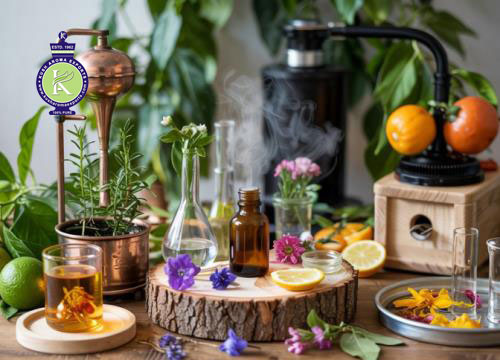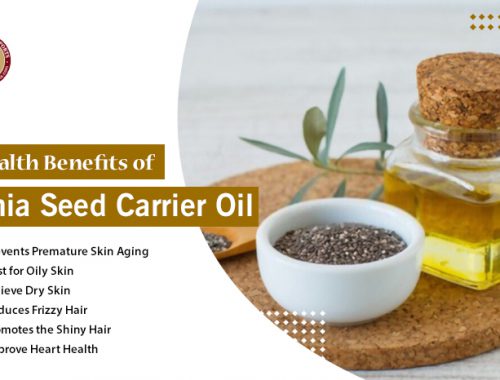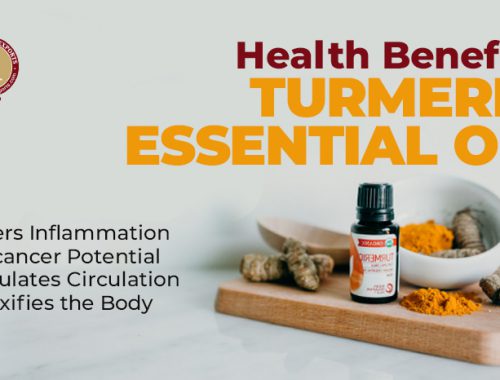Essential oils are nature’s fragrant miracles. Extracted from flowers, leaves, stems, seeds, and roots, these concentrated liquids are packed with therapeutic benefits. Whether you’re looking to buy in bulk for your e-commerce store or trying to create your own blend at home, understanding how essential oils are extracted is crucial. This blog dives into the different methods of essential oil extraction, both traditional and modern. We’ll cover techniques like steam distillation, cold pressing, and CO2 extraction. We’ll also guide you on how to choose the right essential oil extraction machine and even share tips on how essential oil extraction at home works. If you’ve ever wondered how your favorite essential oil extracted from petals like rose or jasmine ends up in a tiny bottle, this blog is your ultimate guide.
Why Extraction Method Matters
Think of essential oil extraction like making coffee. The quality of beans, temperature of water, and brewing time all affect the final taste. Similarly, different extraction techniques yield different grades of essential oils.
Why does this matter for you?
- Buyers need to know whether an oil is cold-pressed or solvent-extracted. This affects purity, shelf life, and even pricing.
- DIYers should pick a method suited to their equipment and the plant material they have access to.
- Manufacturers need methods that yield high purity and large volume without compromising safety.
For example, essential oil extracted from petals like jasmine or rose often requires delicate methods such as enfleurage or solvent extraction. Using steam would destroy their fragrance. That’s where your knowledge makes a real difference in getting the highest quality oil, whether for personal use or resale.
Most Popular Methods of Essential Oil Extraction
There’s no one-size-fits-all when it comes to extracting essential oils. Each method has its own process, equipment, and suitability for certain plants.
Main methods include:
- Steam Distillation: Most common and cost-effective for commercial use
- Cold Pressing: Used mainly for citrus peels
- Solvent Extraction: Best for delicate flowers
- CO2 Extraction: High-end, high-purity method
- Maceration: Simple method using carrier oils
- Enfleurage: Traditional and rarely used but excellent for fragile petals
Each of these techniques brings out unique characteristics in the oil. Whether you’re a buyer evaluating product quality or a hobbyist learning essential oil extraction at home, knowing the method used is essential for your goals.
Steam Distillation
This is hands-down the most widely used method to extract essential oils especially in commercial settings. If you’ve ever bought peppermint, eucalyptus, or lavender oil, chances are they were steam-distilled.
How It Works:
- Plant material is placed in a distillation chamber.
- Steam passes through it, vaporizing the essential oils.
- The vapor travels through a condenser where it cools into liquid form.
- Oil separates from water due to differences in density and is collected.
Pros:
- Ideal for tough plant materials like leaves, bark, and seeds
- No chemicals involved, so it’s natural and clean
- Cost-effective for bulk production
Cons:
- Not suitable for delicate flowers (can destroy fragrance)
- Requires an essential oil extraction machine for efficient results
Best Used For:
- Lavender
- Tea Tree
- Rosemary
- Essential oil extracted from petals like rose, only if done with care
Tip When you buy: If you’re purchasing oils for resale or formulation, ask the supplier for the extraction method used. Steam-distilled oils are typically labeled as “100% pure” and “therapeutic grade.”
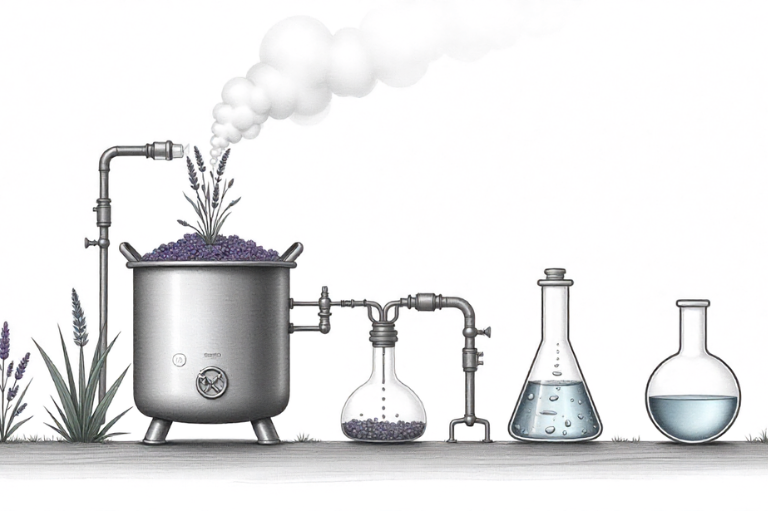
CO₂ Extraction
CO₂ extraction—short for Supercritical Carbon Dioxide extraction—is a high-tech method that uses pressurized CO₂ to pull out essential oils from plant material. It’s one of the cleanest and most efficient ways to obtain pure oils with no solvent residues.
How It Works:
- CO₂ is converted into a supercritical state (part gas, part liquid).
- This supercritical CO₂ acts as a solvent to dissolve essential oils.
- Once the process is complete, CO₂ evaporates, leaving behind pure oil.
Pros:
- Extremely pure and potent oils
- No heat involved, preserving sensitive compounds
- Longer shelf life
- No toxic residues
Cons:
- Expensive equipment
- Not suitable for home use
- More expensive oils
Best For:
- Chamomile
- Ginger
- Frankincense
- Delicate herbs and spices
Why It Matters to Buyers:
CO₂-extracted oils are considered the gold standard for purity. If you’re purchasing essential oils for health, wellness, or food applications, this method is ideal. Kush Aroma Exports offers a range of CO₂ oils that meet international safety and purity standards, making them ideal for high-end buyers and exporters.
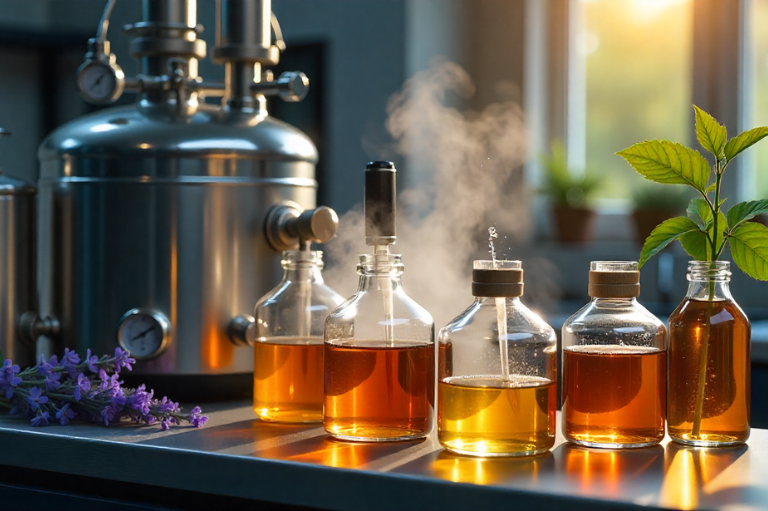
Maceration
Maceration is a simple technique where plant material is soaked in a carrier oil (like olive or sunflower oil) to extract the essential compounds. It’s not exactly an essential oil extraction in the purest sense, but it’s widely used for herbal-infused oils.
How It Works:
- Dried or fresh plant parts are soaked in warm carrier oil for days or weeks.
- The plant material is then strained out.
- The resulting oil contains the plant’s essence, though not as concentrated as steam-distilled oils.
Pros:
- Great for at-home users
- Low-cost and easy to perform
- Perfect for gentle skin applications
Cons:
- Not true essential oil
- Lower potency
- Shorter shelf life
Common Plants Used:
- Calendula
- Arnica
- St. John’s Wort
- Lavender (for massage oils)
For DIY Enthusiasts:
If you’re experimenting with essential oil extraction at home, maceration is the easiest place to start. While it doesn’t yield pure essential oil, it’s great for making massage oils or salves. For buyers, it’s crucial to understand whether a product is a macerated oil or a true essential oil—especially if you’re selling or formulating.
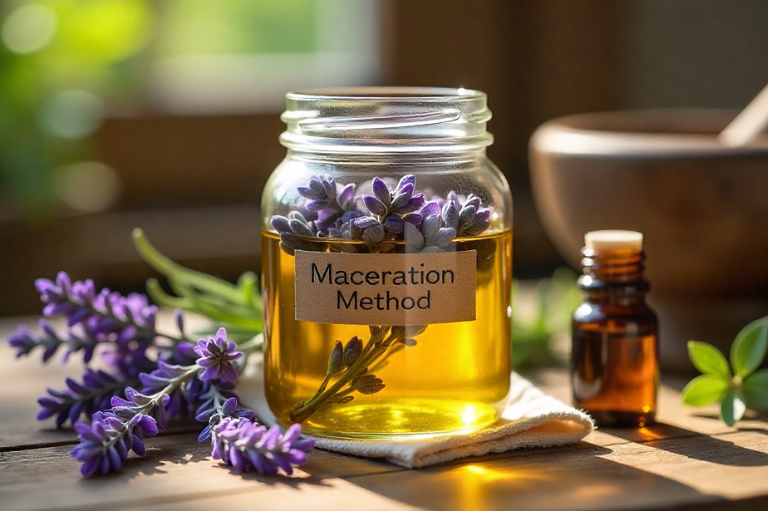
Enfleurage
Enfleurage is a traditional method that’s rarely used today due to its time-consuming nature and high labor cost. However, it’s still one of the best ways to extract oils from extremely delicate flowers like jasmine and tuberose, especially when the true fragrance is desired.
How It Works:
- Fresh flower petals are placed on sheets of glass coated with odorless animal fat.
- The fat absorbs the fragrance over several days.
- The process is repeated with fresh petals until the fat is saturated.
- Alcohol is used to extract the essential oil from the fat, resulting in an absolute.
Pros:
- Captures the true fragrance of delicate flowers
- No heat or harsh chemicals involved
- Luxurious and rare
Cons:
- Labor-intensive
- Expensive
- Limited availability
Best Used For:
- Jasmine
- Tuberose
- Gardenia
Why This Matters to Buyers:
If you’re dealing in high-end perfumery oils, enfleurage absolutes are a niche but prized offering. Always confirm the method used to ensure product quality matches your target market.
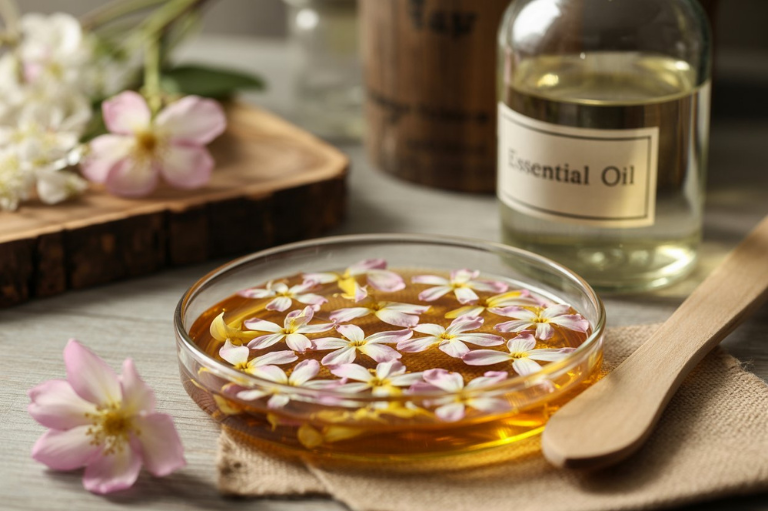
Essential Oil Extraction at Home
Extracting essential oils at home has become a popular hobby for wellness enthusiasts and DIYers. While you won’t be able to achieve the same concentration or purity as industrial methods, you can still create aromatic oils that are great for personal use. Plus, it gives you a deeper appreciation of what goes into each drop of oil you buy.
Common DIY Methods:
- Steam Distillation with Kitchen Utensils:
- Use a pot, heat-resistant bowl, and lid.
- Add plant material and water; collect the oil as steam condenses.
- Maceration (Infusion):
- Soak dried herbs or petals in a carrier oil.
- Store in a sunny window for 2–3 weeks, shaking daily.
- Cold Press (For Citrus Only):
- Grate or peel citrus skins.
- Press and filter the oil manually using cheesecloth or a press.

Tips for Beginners:
- Start with herbs like mint, rosemary, or citrus peels—they’re easy to work with.
- Always sterilize your equipment to avoid contamination.
- Store your homemade oils in dark glass bottles away from sunlight.
Things to Keep in Mind:
- Home extractions are not as concentrated as commercial oils.
- Heat-sensitive plants may lose aroma during the process.
- Essential oil extraction at home is better suited for small, personal batches—not commercial resale.
Buyer Insight:
Understanding home extraction helps consumers appreciate the complexity of the oils they purchase. If you’re selling to this audience, showcasing the professional difference of industrial-grade oils.
Cold Pressed Extraction
The cold pressed method—also known as expression—is a mechanical technique used to extract essential oils from citrus fruit peels without the use of heat or solvents. It relies on physically pressing or grinding the fruit’s outer rind to release its oil. This method preserves the oil’s natural aroma, making it especially valuable for aromatherapy, cosmetics, and natural skincare products.
Best for: lemon, orange, grapefruit, lime, bergamot
Pros:
- Preserves fresh, vibrant citrus aroma
- No heat involved—retains all natural compounds
- No solvents or chemicals used
- Eco-friendly and straightforward process
Cons:
- Limited to citrus oils
- Cold-pressed oils oxidize faster (shorter shelf life)
- Lower yield compared to steam or CO₂ extraction
Why this matters for buyers:
Cold-pressed oils are ideal for buyers looking for fresh, food-grade, or cosmetic-grade essential oils with a clean extraction profile. These oils maintain the exact essence of the citrus fruit and are perfect for brands promoting natural, minimally processed products.
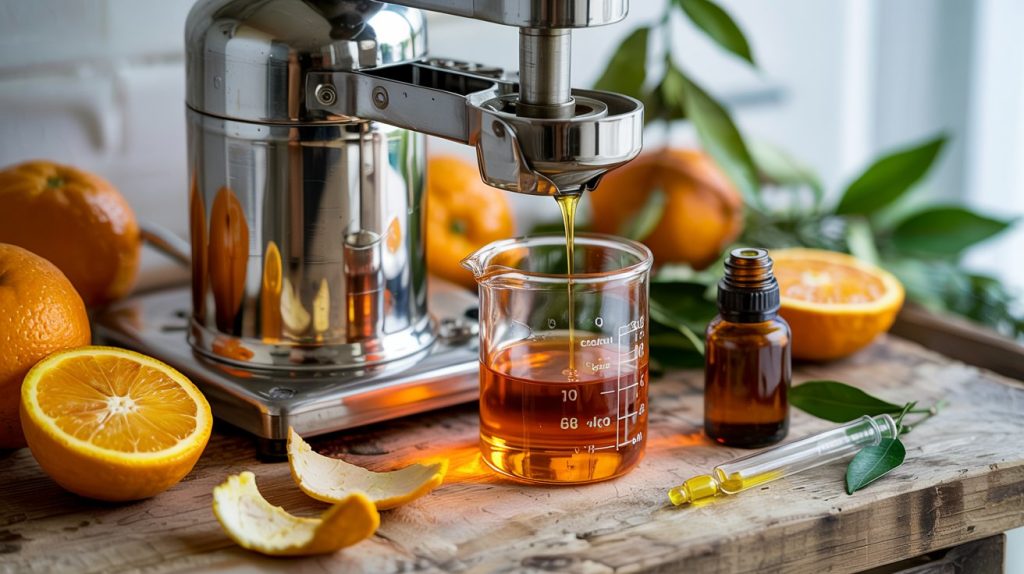
Choosing the Right Essential Oil Extraction Machine
For businesses and advanced DIYers, investing in a quality essential oil extraction machine is a game-changer. These machines simplify the process, improve yield, and maintain oil purity—especially if you plan to sell essential oils commercially.
Factors to Consider:
- Type of Extraction:
- Steam distillation machines are the most common for all-purpose oils.
- Cold press machines are limited to citrus.
- CO₂ extraction machines are for high-end commercial use only.
- Size & Capacity:
- Small tabletop models work for home use.
- Large industrial machines are ideal for bulk suppliers and businesses.
- Material:
- Stainless steel or copper machines are best for preserving oil quality.
- Ease of Cleaning:
- Residue buildup can compromise oil purity, so choose a machine that’s easy to clean.
Best Features to Look For:
- Temperature control
- Pressure gauges
- Condensation coils
- Safety valves
Maintenance Tips:
- Clean after every use to prevent cross-contamination.
- Regularly check gaskets and valves for wear and tear.
- Store in a dry place to avoid rust or damage.
Comparing Methods: Which One is Best?
Not every plant behaves the same, and not every method suits every need. Here’s a comparison to help buyers and producers choose the best technique based on plant type, budget, and purpose.
| Method | Best For | Pros | Cons |
|---|---|---|---|
| Steam Distillation | Herbs, Leaves, Seeds | Natural, efficient, scalable | Not ideal for delicate flowers |
| Cold Press | Citrus Peels | No heat, fresh aroma | Limited to citrus oils |
| Solvent Extraction | Rose, Jasmine, Tuberose | High aroma, delicate botanicals | Residual solvents, expensive |
| CO₂ Extraction | Herbs, Spices, Flowers | High purity, no residue | Costly machinery, commercial only |
| Maceration | DIY herbs and petals | Easy, low-cost | Not true essential oil, lower strength |
| Enfleurage | Jasmine, Gardenia | Luxurious aroma, no heat used | Time-consuming, high cost |
Conclusion
Essential oils may come in small bottles, but there’s a massive process behind every drop. From steam distillation and cold pressing to CO₂ extraction and enfleurage, each method brings out unique characteristics in the oil. Whether you’re extracting oils at home or sourcing for an international brand, the right extraction method makes all the difference.
For buyers, knowing how your oil is made helps you make smarter choices. For hobbyists, trying your hand at essential oil extraction at home brings you closer to nature. And for businesses, investing in the right essential oil extraction machine ensures consistency, quality, and trust in every bottle.
At Kush Aroma Exports, we blend traditional techniques with modern innovation to deliver nothing but the finest essential oils. Choose wisely, and let the power of nature uplift your brand, your home, and your life.
FAQs
1. Can I extract essential oils at home without a machine?
Yes, methods like maceration or steam distillation using kitchen tools make home extraction possible. However, results won’t be as concentrated as commercial oils.
2. What’s the difference between essential oil and absolute?
Essential oils are typically steam-distilled, while absolutes are solvent-extracted and often used in perfumery due to their intense aroma.
3. Are all cold-pressed oils essential oils?
No. Only oils extracted from citrus peels using cold pressing are considered essential oils. Other cold-pressed oils, like coconut or almond, are carrier oils.
4. How can I ensure I’m buying pure essential oil?
Check for GC/MS reports, proper labeling, and certifications. Reputable suppliers like Kush Aroma Exports provide transparency and documentation.
5. Is solvent-extracted oil safe to use?
When processed properly, yes. High-quality suppliers remove solvent residues, but solvent-extracted oils are generally not recommended for therapeutic use.

